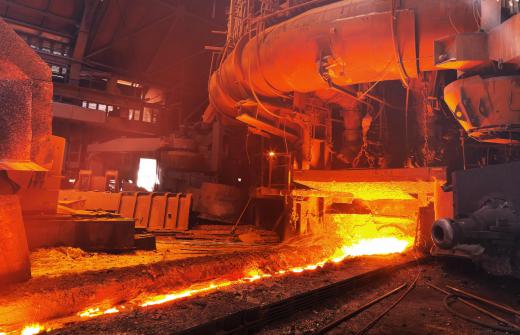At AboutMechanics, we're committed to delivering accurate, trustworthy information. Our expert-authored content is rigorously fact-checked and sourced from credible authorities. Discover how we uphold the highest standards in providing you with reliable knowledge.
What is Muntz Metal?
Muntz metal is a brass alloy invented in the 19th century. A combination of copper and zinc, it was cheaper than traditional copper and began finding uses in many industries, notably shipping. Its light weight and durability has made it one of the most popular alloys in history.
Muntz metal was developed as an alternative to expensive, heavy copper. It is comprised of about 60 percent copper and about 40 percent zinc, with a small amount of iron. The finished product actually is considered a form of brass, but it has maintained its name.

George Fredrick Muntz invented the copper zinc hybrid in 1832 in Birmingham, England. Muntz moved his operations to an ironworks and began producing the metal after it became popular for a variety of shipping purposes. At that time, it cost two-thirds as much as copper but proved to be just as strong and reliable. His company produced several thousand tons of Muntz metal during its peak in the 1840s. His patent expired in 1846, and the alloy began being produced by a variety of competitors.
Muntz metal brass is produced by a unique process of blending the metals together at different times. The copper is melted first in a reverberatory furnace, and the zinc is infused second. The hot, viscous liquid is drained into clay-lined pans to be ladled into molds. The alloy then cools in iron ingot molds before it is formed into its final state, usually a thin sheet or a bolt. After the metal is dipped in a solution of weak sulfuric acid and washed with water, it is ready for use.
Muntz metal can be used for anything that copper is used for, but the shipping industry has accepted this alloy more than any other. In the 1800s, it first gained popularity as an alternative to copper for lining hulls on boats. It was discovered that a sheet of this metal also could be wrapped around the piles of piers because it would not corrode as quickly as copper. Muntz metals still are in use today and are most commonly used in bolts because they are inexpensive and very strong.
George Muntz's creation has been a staple of the manufacturing industry for almost 200 years because of its cost and durability. It has found success in the shipping and bolt manufacturing industries as an alternative to copper. Muntz metal is an alloy that is used by builders around the world.
AS FEATURED ON:
AS FEATURED ON:











Discussion Comments
Is this something that a normal consumer could buy in sheet and/or plate form? In my free time I like to do tin punching and other small scale metalworking projects.
Regular craft shops usually just have tin and what I think is brass to use for punching. Since I have done a dozen or so projects so far, I am thinking of trying to experiment with using different metals. I have had a few people say they really like the look of copper.
If Muntz metal is available, how easy is it to work with? What is its stiffness compared to something like aluminum or tin? I'd also like to know where I might be able to buy it and how much it would cost.
I'm wondering what the properties are for welding this metal. I have only started welding and don't have too much experience, but I do know that different metals and have very different effects when welding.
There are also several welding techniques that be used for different metals. I would be interested to hear from someone who has experience with welding Muntz metal or copper and how that compares to some of the other materials like iron or steel.
I'm curious how you would tell the difference between Muntz metal compared to copper and brass. I don't know what the normal proportions are for brass. I would guess that brass probably has more copper, and would be darker in color than Muntz metal. It would probably be heavier, too. I think zinc if a fairly light metal.
The mixing process might have something to do with the difference, as well. What is the purpose of adding the zinc later in the blending process? Does it add to the strength of the metal somehow?
@Emilski - I agree with you. I'm shocked that I've never even heard the term Muntz metal before. I wonder if maybe it gets used, but is just sold as brass or copper. That seems a little misleading on the part of the manufacturers, though, since it is much cheaper to make than the other metals.
Out of curiosity, if you found something you knew to be Muntz metal, could you sell it as scrap metal? What kind of price would you receive compared to brass or copper? I know that copper is very expensive. I'm not sure about brass.
I can't believe I have never heard of this. Did I interpret the article right that Muntz metal is still in use? Maybe since I don't know anything about ship building, I have just never heard of it. Does it possibly go by another, more common name nowadays?
Are there any other uses for the metal besides ship building?
Post your comments